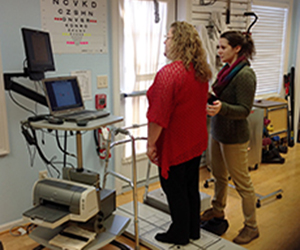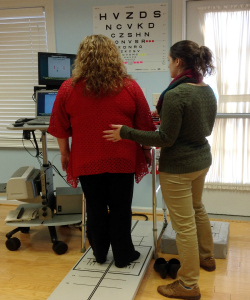Disequilibrium of Aging
 The primary symptoms of a Vestibular Disorder include dizziness, vertigo, and Disequilibrium. Dizziness is a sensation of lightheadedness or unsteadiness. Vertigo is a perception of movement of the self or surrounding objects that most people described as spinning and can be quite disabling.. Dizziness and Vertigo can be a symptom of many Vestibular Diseases and Disorders, The WWSPT experts will evaluate the type of dizziness to help find what type of vestibular dysfunction you are having.
The primary symptoms of a Vestibular Disorder include dizziness, vertigo, and Disequilibrium. Dizziness is a sensation of lightheadedness or unsteadiness. Vertigo is a perception of movement of the self or surrounding objects that most people described as spinning and can be quite disabling.. Dizziness and Vertigo can be a symptom of many Vestibular Diseases and Disorders, The WWSPT experts will evaluate the type of dizziness to help find what type of vestibular dysfunction you are having.
Disequilibrium means unsteadiness and him balance that can be accompanied by a spatial disorientation. In and this may present itself as stumbling or difficulty walking a straight line will or turning. Other signs and symptoms include visual spatial problems, hearing loss, frequent falls, and difficulty moving in the dark, difficulty reading, difficulty concentrating and increased anxiety.
An estimated 33% of all adults with chronic balance problems experience difficulty performing basic activities of daily living such as bathing dressing eating and walking safely without falls. We don’t notice what the vestibular system does for us until it is not working properly. It can be very disabling for many people though with the right treatment and diagnosis we can manage your symptoms and often cure them.
The staff members at WWSPT are the regions experts on the care the Vestibular Dysfunction. No matter the diagnosis they provide the newest in evidence-based medical care for our patients. We are involved with leading research in the treatment of some of the most common forms of Vertigo and teach other physical therapists how to appropriately treat Vestibular patients.
Computerized Balance testing with Neurocom Balance Master
Falls are common in those with vestibular dysfunction and can have serious consequences when they result in injury, therefore it is important to prevent them as much as possible .To thoroughly assess balance deficits we use a computerized assessment with a balance master to provide objective data regarding sensory input and postural control. This enables our therapists to develop a more effective program to prevent falls or improve your balance. The assessment data is maintained in our system and compared to age normal’s therefore giving you a measure of your abilities compared to your peers. It can also be compared internally on future visits to demonstrate improvement or on yearly evaluations to prevent decline in balance ability. The test is similar to a Wii game except the data is collected and can be compared during each session. This can help us evaluate your fall risk and help us develop a fall prevention program tailored specifically to you.


